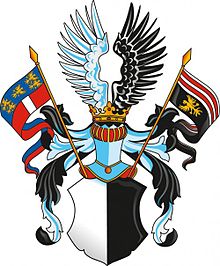Abensberg-Traun
- View a machine-translated version of the German article.
- Machine translation, like DeepL or Google Translate, is a useful starting point for translations, but translators must revise errors as necessary and confirm that the translation is accurate, rather than simply copy-pasting machine-translated text into the English Wikipedia.
- Consider adding a topic to this template: there are already 9,118 articles in the main category, and specifying
|topic=will aid in categorization. - Do not translate text that appears unreliable or low-quality. If possible, verify the text with references provided in the foreign-language article.
- You must provide copyright attribution in the edit summary accompanying your translation by providing an interlanguage link to the source of your translation. A model attribution edit summary is
Content in this edit is translated from the existing German Wikipedia article at [[:de:Abensperg und Traun]]; see its history for attribution. - You may also add the template
{{Translated|de|Abensperg und Traun}}to the talk page. - For more guidance, see Wikipedia:Translation.

The House of Abensberg und Traun (now usually written Abensperg-Traun) is the name of an ancient Austrian noble family, originally from the Upper Austrian Traungau. It is considered one of the oldest extant aristocratic families in Central Europe.
History
The Abensberg und Traun family was first mentioned with Pernhart de Trune in 1114. Traun Castle is still today owned by the family. The Trauns are one of the 12 so-called "Apostle Houses", i.e. the families which had already played a historical role during the period of Babenberg rule of Austria (976 to 1246).
They were elevated to Imperial Counts in 1653, receiving the name Counts of Abensperg and Traun, after a Bavarian family, the counts of Abensperg, who had a similar coat of arms, and had ruled the county of Abensberg (Bavaria) from the 12th century until they extinguished with Niclas, Graf von Abensberg in 1485. Only count Ernst von Abensperg und Traun (1608–1668) was very shortly granted the fief of Abensberg when the Habsburg emperor Leopold I occupied Bavaria during the War of the Spanish Succession.
From 1656 the Abensperg and Traun family held a seat on the "Swabian counts' bench" of the Imperial Diet and in 1662 purchased the Lordship of Eglofs, a lordship with Imperial immediacy. It was sold to the Windisch-Graetz family in 1804.[1][2]
To this day, the Abensperg und Traun family owns large estates in Austria, as well as a number of castles and fortresses.
Notable family members
- Otto Ferdinand von Abensberg und Traun (1677-1748), Austrian aristocrat
Residences
-
 Traun castle (owned since 1120)
Traun castle (owned since 1120) - Palais Abensperg-Traun, Herrengasse, Vienna (1401-1855)
-
 Maissau Castle (owned since 1526)
Maissau Castle (owned since 1526) -
 Petronell Castle (1656-2006)
Petronell Castle (1656-2006) -
 Groß-Schweinbarth Castle (owned since 1661)
Groß-Schweinbarth Castle (owned since 1661) - Burg Rappottenstein (owned since 1664)
- Palais Abensperg-Traun, Weihburggasse, Vienna (owned since 1872)
References
External links
 Media related to Abensperg-Traun family at Wikimedia Commons
Media related to Abensperg-Traun family at Wikimedia Commons
- v
- t
- e
 | This Upper Austria location article is a stub. You can help Wikipedia by expanding it. |
- v
- t
- e



















